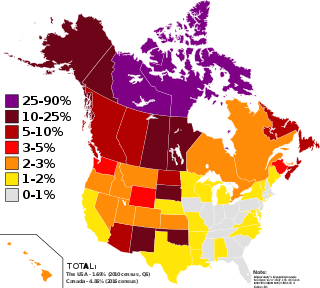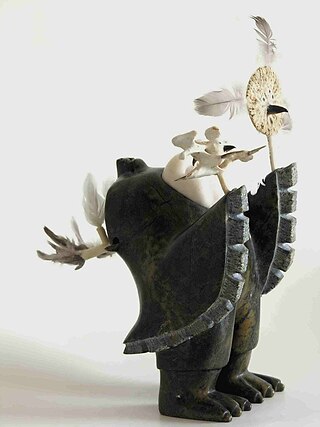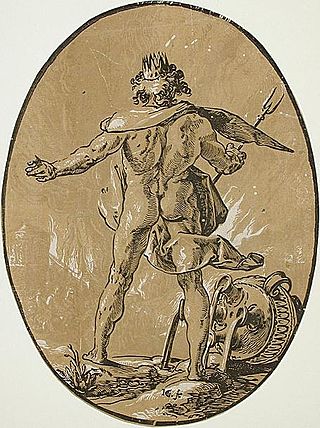
Iqaluit is the capital of the Canadian territory of Nunavut, its largest community, and its only city. It was known as Frobisher Bay from 1942 to 1987, after the large bay on the coast on which the city is situated. In 1987, its traditional Inuktitut name was restored.

A trident is a three-pronged spear. It is used for spear fishing and historically as a polearm.

In Canada, Indigenous groups comprise the First Nations, Inuit and Métis. Although Indian is a term still commonly used in legal documents, the descriptors Indian and Eskimo have fallen into disuse in Canada, and most consider them to be pejorative. Aboriginal peoples as a collective noun is a specific term of art used in some legal documents, including the Constitution Act, 1982, though in most Indigenous circles Aboriginal has also fallen into disfavour.

Cambridge Bay is a hamlet located on Victoria Island in the Kitikmeot Region of Nunavut, Canada. It is the largest settlement on Victoria Island. Cambridge Bay is named for Prince Adolphus, Duke of Cambridge, while the traditional Inuinnaqtun name for the area is Ikaluktutiak or Iqaluktuuttiaq meaning "good fishing place".

Nain is the northernmost permanent settlement in the Canadian province of Newfoundland and Labrador, within the Nunatsiavut region, located about 370 km (230 mi) by air from Happy Valley-Goose Bay. The town was established as a Moravian mission in 1771 by Jens Haven and other missionaries. As of 2021, the population is 1,204 mostly Inuit and mixed Inuit-European. Nain is the administrative capital of the autonomous region of Nunatsiavut.

Australian Aboriginal artefacts include a variety of cultural artefacts used by Aboriginal Australians. Most Aboriginal artefacts were multi-purpose and could be used for a variety of different occupations. Spears, clubs, boomerangs and shields were used generally as weapons for hunting and in warfare. Watercraft technology artefacts in the form of dugout and bark canoes were used for transport and for fishing. Stone artefacts include cutting tools and grinding stones to hunt and make food. Coolamons and carriers such as dillybags, allowed Aboriginal peoples to carry water, food and cradle babies. Message sticks were used for communication, and ornamental artefacts for decorative and ceremonial purposes. Aboriginal children’s toys were used to both entertain and educate.

Akulivik is an Inuit village in Nunavik, in northern Quebec, Canada. It is located on a peninsula that juts southwesterly into Hudson Bay across from Smith Island, Nunavut (Qikirtajuaq). Akulivik lies 1,850 km north of Montreal.

Inuit art, also known as Eskimo art, refers to artwork produced by Inuit, that is, the people of the Arctic previously known as Eskimos, a term that is now often considered offensive. Historically, their preferred medium was walrus ivory, but since the establishment of southern markets for Inuit art in 1945, prints and figurative works carved in relatively soft stone such as soapstone, serpentinite, or argillite have also become popular.

Kangiqsujuaq is a northern village in Nunavik, Nord-du-Québec, Quebec, Canada. It had a population of 837 in the Canada 2021 Census. The community has also been known as Wakeham Bay. The name "Kangiqsujuaq" means "the large bay" in Inuktitut.

Historically Inuit cuisine, which is taken here to include Greenlandic cuisine, Yup'ik cuisine and Aleut cuisine, consisted of a diet of animal source foods that were fished, hunted, and gathered locally.

A bident is a two-pronged implement resembling a pitchfork. In Greek mythology, the bident is a weapon associated with Hades (Pluto), the ruler of the underworld.
Killiniq is a former Inuit settlement, weather station, trading post, missionary post, fishing station, and Royal Canadian Mounted Police post on Killiniq Island. Previously within Labrador, and then the Northwest Territories, it is now situated within the borders of Nunavut. The community closed in 1978.

Qajartalik is a petroglyph site located on the Qajartalik peninsula of Qikertaaluk Island, Nunavut, approximately 40 km southeast of Kangirsujuaq, Quebec. The site consists of over 150 carvings of faces in soapstone. It was created by the Dorset people, the culture who inhabited the Canadian eastern Arctic and Greenland beginning approximately 2,200 years ago before disappearing approximately 1,000 years ago, and who inhabited the region prior to the Thule Inuit who arrived approximately 800 years ago. It is believed to be the northernmost rock art site in North America and is considered to be one of a kind. The site is currently on Canada's tentative list of sites proposed for inscription on the UNESCO World Heritage List.
Siasi Atitu (c.1896–1983) was a Canadian–Inuit artist known for her stonecut printmaking. She was active in the 1960s. And had many variations of name including Siasi Atitu Pamiu.
Isa Paddy Aqiattusuk (1898–1954) was an Inuit artist.
The Avataq Cultural Institute is Nunavik's official organization for the preservation and promotion of the Inuktitut language and Inuit culture. Avataq has departments that deal with ethnography and art, as well as a library, archive and language programs.
Lucassie Sandy Nowra was an Inuit artist.
Adamie Niviaxie (1925–?) was an Inuk sculptor.
Tivi Ilisituk is an Inuk hunter and carver from Salluit, Quebec.
Johnny Inukpuk was an important Inuit artist, known as a sculptor and storyteller. His son Charlie Inukpuk is also a sculptor.















